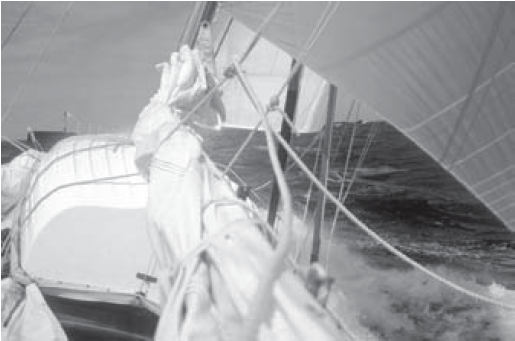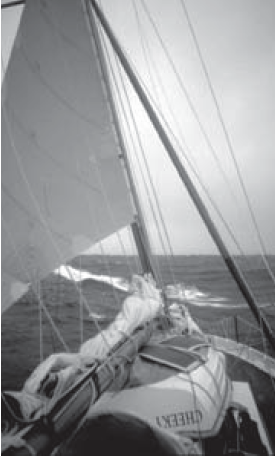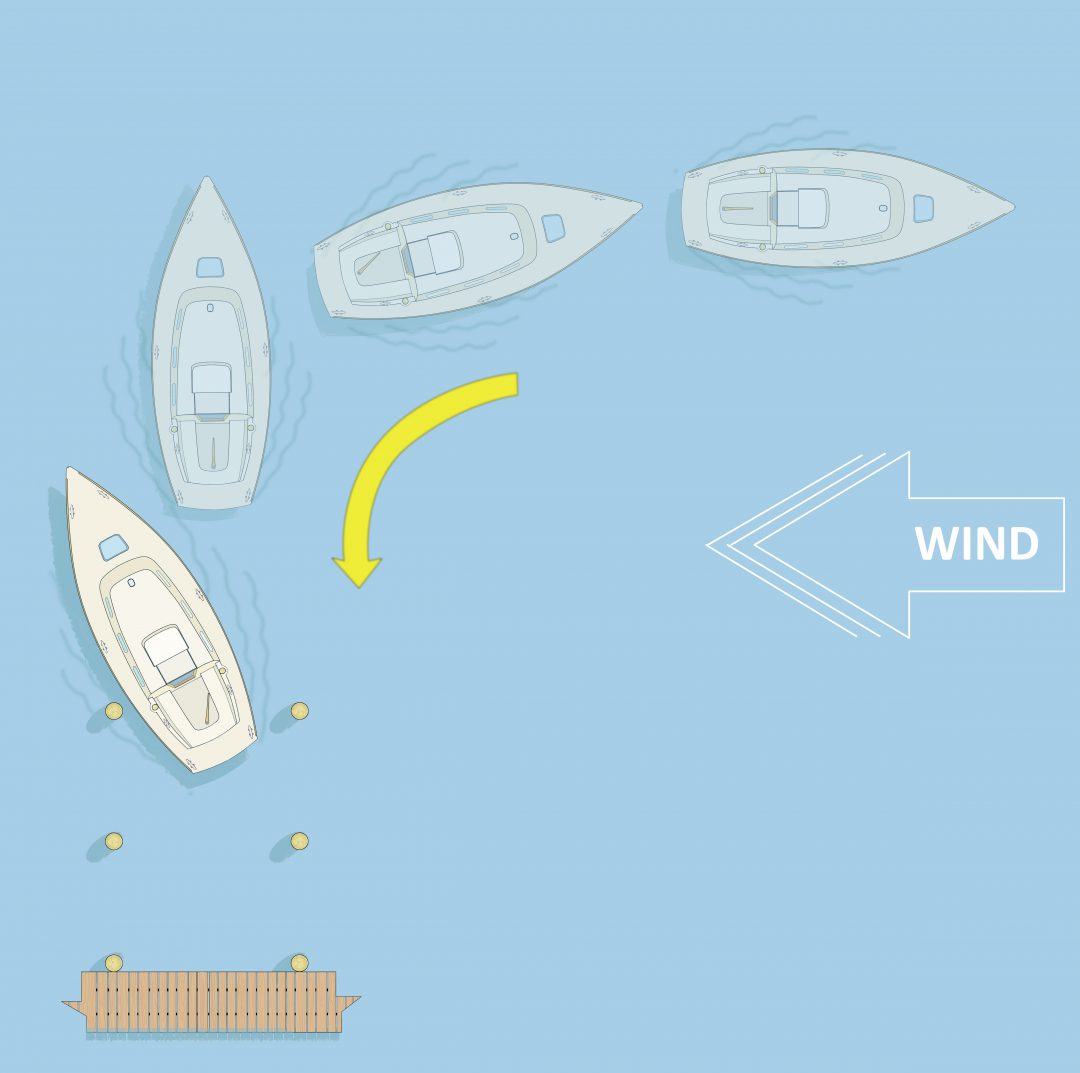Tips from a world-cruising fellow sufferer
It never fails. Every time we get into a discussion with a new or would-be cruising sailor, there comes a moment when a concerned look crosses his or her face and the question is blurted out, “Do you ever get seasick?”
I don’t think any aspect of sailing causes more worry. Certainly nothing is more demoralizing than being seasick. I know; I’m one of the sufferers. There we were, finally on our way after three-and-a-half years of scheming, planning, and building. I’d sailed lots of times before, but when we set off from San Diego into a confused cross sea, I was so sick that I finally ended up lying on the cabin sole praying for land.
“All my dreams ruined,” I said to myself. And even more morbid thoughts rushed through my head. Larry tried joking with me, holding me, teasing me, but nothing helped. To my amazement, on the second day out my seasickness began to fade away. By the end of the day, I was more than making up for my lack of interest in food. After three days, I had forgotten that I ever was seasick.
I still get uncomfortable occasionally, and every time it happens I am just as unhappy as the first time, but I have learned to minimize the problem. I don’t include Larry in the problem because he is one of the outrageously fortunate 10 percent who don’t know what seasickness is. Put him in a boat with bilges full of diesel, odiferous food on the counter, and a vicious sea running and he’ll ask where the butter and jam are so he can make a sandwich. But about 90 percent of all people who go to sea do suffer at one time or another. So an active program of prevention is worth considering.
Psychological problem
I’m convinced that 30 to 50 percent of the problem is psychological, and other long-time sailors have supported me in this belief. Curiously, I never get sea- sick when we are working to deliver other boats, only when Larry and I are sailing alone on our own boat. When I am being paid to cook on a delivery I’ve got important responsibilities and don’t want to let the crew down, so I guess I’m busier or trying harder.
On board Taleisin, I know Larry will take care of any problems, and he handles the boat easily by himself with the aid of our self-steering gear, so I can relax and it doesn’t matter. Peter Phillips, who owns 50-foot Voyager, reports the same thing. When he is captain and has a crew on his own boat, he’s never seasick. But daysailing as a guest on friends’ boats is a different matter. I’m not in any way saying that our seasickness is any less real for being psychological. But by accepting the fact that sometimes it is caused by mental processes, we can more actively fight it.
Drug companies are forever coming up with new pills to fight the problem. Unfortunately, they often forget to put the most important instructions on the package. To work at all, any anti-motion-sickness pill must be taken one hour before the motion starts. Once you are leaving the marina, it’s too late. It takes one hour for some pills to dissolve and spread through your body. If you vomit before then, you lose the medicine.
After 40 years of voyaging, I still have to deal with a day or two of sea- sickness every time we set off into a fresh wind with sloppy sea conditions. Even when I have been at sea awhile with gentle weather, I have encountered bouts of head-in-the bucket-seasickness when the weather turned stormy. I have tried drinking ginger beer, using a wristband, and taking a mild tranquilizer. (Although other sailors found tranquilizers to be a solution, they only worked for me in some situations.)
Children’s tablet
After much experimentation I now use Stugeron, a children’s motion-sickness tablet which has cinnarizine as an active ingredient. (Note: Stugeron does not appear to be available in the U.S.–Ed.) I take a child’s dose one hour before leaving port with good results and very little of the feeling of lethargy associated with other remedies. Surprisingly, I have found this medication tends to work even when I am already feeling a bit off, as long as I take the tablet with a dry biscuit or two and a small glass of fruit juice, then lie down for an hour. This is especially helpful when a voyage starts out calmly and deteriorates after a few days.
Wristbands supplied by acupuncturists have been very successful for several friends, and so has “the patch” (transdermal Scopolamine 1.5 mg., available by prescription). But if you are allergic to the adhesive used on most bandages, as I am, you will have a skin reaction at the site of the patch. Some people have tried reducing the dosage from the patch by cutting it in half. This is definitely not recommended, as most people will get a rash where the cut edge of the medication- dispensing gauze touches the skin. Furthermore, the slow-release action of the patch will no longer function correctly.
Whatever medication you choose, consider the potential side effects care- fully, especially if you plan to use the medication for more than a day or two. Some people, who depended on a patch for the whole length of a voyage, found they had hallucinations after a few weeks at sea. Even after removing the patch, this continued for a few days.
Dosage is another problem often overlooked with seasickness remedies. Over-dosage causes sleepiness and dry mouth and can impede urination. It tends to occur more often in women than in men because the aver- age weight of adults used to deter- mine medicinal dosage is 140 pounds. If you weigh 110 pounds or less, you should probably be taking a young person’s dosage.
If you find a medication that works for you, take at least a year’s supply along if you’re heading out on a long cruise. It is often difficult to find an exact duplicate in the countries you’ll visit. Furthermore, a medication that is available over the counter in one country might require a local doctor’s prescription in another.

Other measures
Whether you want to use anti-motion-sickness pills, tranquilizers, or go without, there are other measures you can take to minimize seasickness. First, keep your boat very clean. Eliminate any odors you can. It’s the odors that do the final trick. A person can be fine until he opens the ice chest and gets a whiff of blue cheese or sour milk. In fact, people get seasick less easily on a boat with no engine. There are fewer engine-related odors to become accustomed to in a non-auxiliary vessel. If you have an engine, don’t overfill the tanks, be sure to check for leaks, and wipe excess oil off the engine.
Ventilate the boat well and remember that odors you live with day in and day out may not upset you, but they may do the trick for a guest. Don’t al- low anyone to smoke if you or one of your guests is prone to seasickness. If you are embarrassed to ask your friends to snub out their cigarettes, put up a sign, “Smoking allowed on deck forward of the mast.”
Second, if you or your guests have a tendency to get queasy, try living on board at anchor for a few days before you head to sea. The slight motion afloat seems to help you get acclimated. People who live on board constantly suffer less when they head to sea.
Third, rest well before you set off. I know now that my first real bout of seasickness was brought on by too many farewell parties and an excitement-induced sleepless night before our departure. At sea, get all the rest you can. Your body can cope with weather changes better, and mentally you’ll be less annoyed if some queasiness does occur.
Fourth, if you happen to be in charge of cooking, prepare enough meals for two or three days before you leave port or, if you are on a long passage, when it is calm. I usually make up a pot of stew or spaghetti and sauce or a really thick soup in an eight-quart pot. I mix sandwich fillings and bake fresh bread before each long passage. Then, once we set off I don’t have to put up with the unsettling smells of cooking if it’s rough. And if I do get seasick, I don’t have to worry; Larry can turn a fire on under the pot of soup or stew and scoop a bowlful for himself. If you have prepared several meals beforehand and you don’t get seasick, you end up with a bit of extra free time at sea to sun-bathe or to read a good book.

Pronounced motion
Fifth, once you are under way in a rough sea, avoid going into either the forepeak or the engine room. The motion is more pronounced in these parts of the boat. Also, if possible, avoid using an enclosed toilet. Head areas are rarely ventilated well enough, and the odors multiply when you are in a sea- way. Try a bucket if it’s really rough.
Sixth, keep warm and active and stay out in the fresh air. Because seasickness is partially psychological in many cases, if you put on your foul-weather gear, get out on deck, and join in the sailing of the boat, you won’t have as much time to think about the motion. Very few people who sail dinghies get seasick; they are just too busy sailing.
Seventh, if you have a tendency toward seasickness, avoid hot, spicy food. Choose easily digested items such as bread, oatmeal, apple juice, and saltines, rather than citrus fruits, lasagna, and bacon.
Eighth, on very hot, still days, try to keep cool. It’s amazing how many people become upset on glassy, calm days when the sails are slatting. Find some shade, pour sea water over your- self, or drink a cool glass of juice to prevent sickness.
Ninth, if you do become ill, try drinking some sweet fruit juice such as well-chilled apricot or peach nectar. This seems to settle well and provides almost all of the nutrition necessary to keep you from becoming weak or dehydrated.
Tenth, in really bad conditions, try changing the motion of the boat by easing the sheets a bit and reaching, running, or even heaving-to. We know one tough-looking six-footer who becomes as weak as a baby as soon as the sheets are hauled in hard. He lies in his bunk until the sheets are eased. Then he makes up for lost time and missed meals. He just can’t take the motion of being hard on the wind in anything more than 12 knots or so. But he loves sailing and traveling so much that he’s willing to put up with the inconvenience.
No discouragement
Finally, if you have a first-time sailor on board who becomes seasick, don’t discourage him or her from sailing. One of our best friends spent years learning about boats and building beautiful dinghies, which he sold with an aim of someday having his own yacht. Then he was asked to crew on a 40-foot hot racing machine and accepted excitedly. In 20-knot winds he became helpless. The regular crew of the boat teased him, and he never went sailing again. He would have made a good sailor, but to him sailing wasn’t worth the discomfort and ridicule.
I think that is one of the big secrets: you have to want to sail and cruise so much that you’ll put up with one or two days of discomfort for the reward of new ports and new people.
Normally, few people stay seasick for more than two or three days, except in the most extreme storm conditions. I did hear of one person who reported she was seasick the whole way across the Atlantic. But it turned out she was suffering not from sea- sickness but from a problem that can be caused by seasickness. I learned about this when I spoke to the port doctor in Gibraltar. He told me in the past two years he has had to assist in the delivery of nine unplanned babies conceived by cruising people who were using the pill.
As he explained it, an oral contraceptive must stay in your stomach four to eight hours to spread into your bloodstream effectively. He advises that if you want to be sure of avoiding pregnancy, use other means of contraception such as condoms or abstinence if you have been seasick for more than a day. Pregnancy in its second and third month will cause almost the same symptoms as seasickness, and that was what our friend on her transatlantic voyage was suffering from.
No one enjoys being seasick. But for most of us it is an integral part of going to sea that might have one small bonus: it helps me shed some of the pounds I gained in the previous port. But far more important, the discomfort is quickly forgotten the minute you reach a new port or sail out of a storm into beautiful weather.
Only a few fortunate souls are as immune to seasickness as is Larry Pardey, on facing page. Lin envied his ability to spend almost two hours re- stitching the head of their mainsail as they roared down 20-foot swells before 30-knot trade winds between Chile and the Marquesas. Lin’s stomach could not handle the heavy-weather windward work off the coast of Australia, at right, but once they lay hove to, photo on Page 24, she felt good enough again to eat a welcome warm meal.
This article was excerpted from Lin Pardey’s book, The Care and Feeding of Sailing Crew, which has just been updated and released as a third edition.





